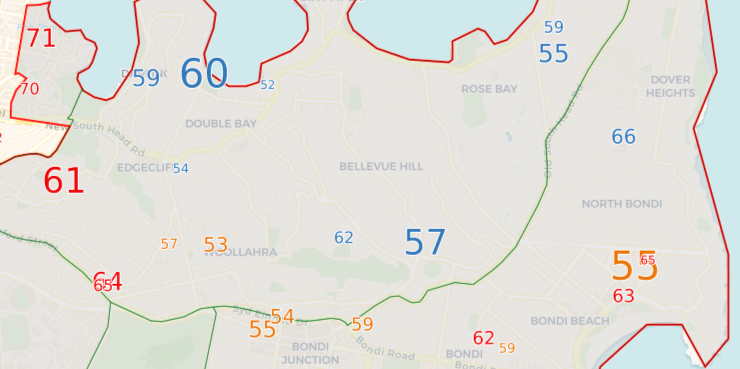Tonight’s election result was very clear. A massive swing against the Liberal Party has pushed the Morrison coalition government into a minority position, with Dave Sharma losing a seat held by the conservative major party since federation, despite a 17.7% margin built up by former prime minister Malcolm Turnbull.
There are many things to say about the causes, and i won’t go into a lot of depth on this point. Clearly the departure of Malcolm Turnbull made it harder for the Liberal Party, and this was made worse by the manner of his leaving. The party’s inability to reconcile its base with sensible policy on climate change made it much harder for them in a seat like Wentworth, and a strong independent like Kerryn Phelps was able to exploit this position.
In this post I’m going to focus on the geography of the electorate, showing how the swings spread across the seat, and how a distinct geographic divide within the seat is much more obvious following this result.
Last week I blogged about “the three Wentworths” – three distinct parts of this electorate I had identified which I believed would behave differently. Specifically, I thought the Liberal Party was more vulnerable to a swing in the city and beach areas than they were in the harbour area. And this has been proven right.
Kerryn Phelps won the two-candidate-preferred vote in every booth in the city and beach areas, while Sharma held on in every booth in the harbour area. While the Liberal Party suffered similar swings in the harbour as they did in the beach, they weren’t enough to lose booths in places like Double Bay, Vaucluse, Watsons Bay or Rose Bay.
This is very clear on this map. You can also toggle to see the anti-Liberal primary vote swing by booth.
You can also see this effect in the following table.
| Voter group | Phelps prim % | LIB prim % | ALP prim % | LIB swing | Phelps 2CP % | Total votes |
| Beach | 33.7 | 32.3 | 13.6 | -20.2 | 59.6 | 23,313 |
| Harbour | 28.0 | 53.3 | 6.9 | -20.8 | 41.0 | 17,407 |
| City | 39.4 | 31.1 | 11.8 | -24.8 | 63.8 | 11,663 |
The map and the table also demonstrate that, while Phelps gained ground across the seat and won clear majorities in the beachside suburbs, her heartland is at the western end of the seat in suburbs like Paddington.
This makes sense considering her role as a City of Sydney councillor.
One more thing: what about strategic voting? There was a lot of concern (partly fuelled by polls) about the prospect that Labor, who were running a credible candidate, could come ahead of Phelps, knocking her out of the race, yet not gain enough preferences to win on their own terms. In the end Labor also suffered a swing, with the centre-left vote shifting towards Phelps.
So were these polls wrong? I’m not so sure. I think it’s quite possible that the last week of the campaign, which saw a lot of attention paid to the question of how progressive voters could vote most strategically, resulted in a shift of support to Phelps. I also suspect Phelps largely regained support she had first attracted early in the campaign, but had subsequently lost after announcing her decision to preference the Liberal candidate over Labor.
We can’t be completely sure, but I think the polls likely did a good job in a very volatile contest.




Its interesting its split north/south, North Sharma preformed strongly, But in the south The independent did better
The areas around the south of the electorate have always had a decent Labor and greens vote. Unsurprising that they went very hard for Phelps, a candidate they thought could win.
Good analysis. How do you (and other commentators) rightly treat Walter Marks’ 1929 win (Independent Nationalist, former Nationalist Party MP) against the endorsed Nationalist? Should it be treated as an exception to the “117 years conservative party” narrative?
Phelps will now be able to consildate her win in 2018 and increase her vote margin in the 2019 election similar to member for INdi and Mayo and CLark
Sharma isn’t dead, if there’s an above average rate of postal returns and an above average postal advantage to the Liberals (conceivable given the last week of the campaign in particular was truly woeful) then he could peg this back to 50-50.
Bennie – you have a point but Phelps will probably still win. AEC results this evening, with 68% counted, the margin is 2590 votes. While postal votes often favour the Liberals in most election I dont think it will be so this time.
Why wouldn’t they favour the Libs this time? They did in Mayo, but Labor may have been running slighty more than no campaign this time?
Its differant Bennee, This is a special By election, there was gaffs and everything
Anthony Green on ABC TV is always correct.
Although i will point out something, On election night 2007, The seat of Bowman was called for Labor (The whole panel called it for Labor), but days later when pre-polls came in Laming got the edge and it became the most marginal coalition seat.
curious why the red and orange presume they are Phelp 2cp and the blue is Shrama
Daniel, it’s not that different. Mayo by-election is the apt comparison because it is also the Liberals in a traditional Liberal seat versus an “independent” that won’t have a postal campaign.
Comments are closed.